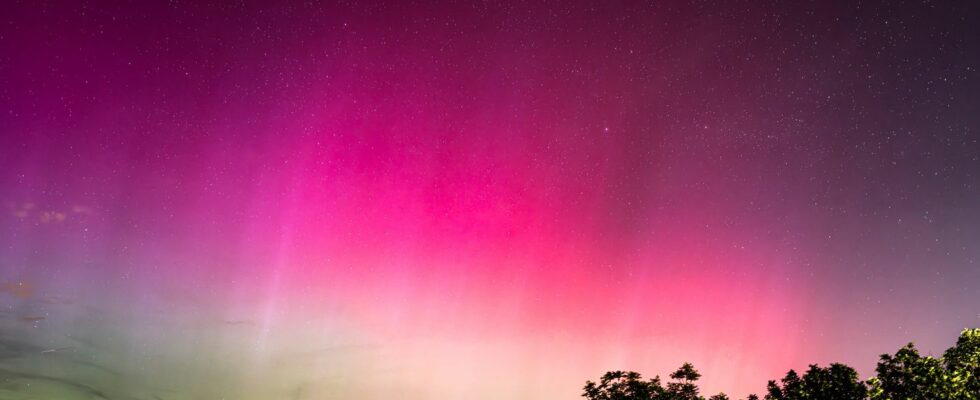An illuminated sky from Europe to the United States and photos as rare as they are breathtaking. The weekend was marked by exceptional northern lights visible in a major part of France, to the great pleasure of astronomers and curious people who were able to observe this rare phenomenon outside the poles.
Caused by a historic solar storm when the Sun entered the maximum activity phase of its cycle – which lasts around eleven years – these apparitions raised many questions. To see more clearly, we take stock with Miho Janvier, astrophysicist from the Institute of Space Astrophysics (Paris-Saclay University, CNRS), specialist in the physics of the Sun and solar storms.
Why do solar storms trigger the Northern Lights?
To understand the phenomenon, we need to go back to the basics. During a solar storm, our star ejects “a sort of cloud which transports material from the Sun in the form of a plasma, a sort of particle soup”, describes the astrophysicist, co-author of the book. Secrets of the Sun (ed. Alisio), published in 2023.
The solar storm will then “resonate the Earth’s magnetic cocoon, the magnetosphere, and the fluctuations of this magnetic field cause geomagnetic storms on our planet,” continues Miho Janvier. The particles around the Earth will accelerate and “collide with the atoms in our atmosphere, in particular oxygen and nitrogen,” she summarizes. And bam, that makes the Northern Lights, which are “the excited and de-excited states of the atoms in the Earth’s atmosphere”. Not easy, eh? But aesthetic…
Why have we seen the Northern Lights where we usually don’t see any (or few)?
If the northern lights are common around the poles – in a fairly well-defined area called the “auroral oval” – at the time of peak activity of the Sun, the latest solar storms are “exceptional” because they made it possible to “see the northern lights at really low latitudes,” explains the specialist.
“It is the succession and intensity of these solar storms that caused the penetration of particles and their collision within the Earth’s atmosphere to occur at much lower latitudes than we are used to,” like in mainland France, describes Miho Janvier. Concretely, “the first storms that arrived at Earth level began to weaken the magnetosphere, then we had a fairly significant one, which caused the magnetic field to vibrate very significantly,” continues the astrophysicist.
Why were the Northern Lights pink and purple and not green?
If several phenomena come into play, such as the latitude at which the northern lights occur, their color is mainly due to the intensity of the geomagnetic storms which cause them. “The more energy we have, the greater the collisions of particles in the atmosphere,” explains Miho Janvier. Depending on the levels of excitation and de-excitation of the particles, the northern lights will have different colors. The Sun specialist illustrates: “With the oxygen atom, generally, we have more of a green phenomenon, but it can also allow rather red colors. With nitrogen atoms, we have blue-violet, even pinkish shades. »
Can the phenomenon happen again?
Bad news for the curious who missed the show during the night from Friday to Saturday: even if it is very difficult to predict the Northern Lights, the chances of seeing them in mainland France in the coming days are low. In question, according to Miho Janvier, “the region which gave rise to several eruptions and solar storms”, which “will pass behind the Sun”. Even if it continues to be active, possible solar storms “will not be directed towards the Earth, so the effects will be less significant, warns the specialist. That doesn’t mean that we won’t have the Northern and Southern Lights, but it certainly won’t be at latitudes in mainland France.”
As for the coming months, “we expect each week to have a lot of activity at the level of the Sun, but that does not necessarily translate into auroral activity as intense as that which we saw on Friday night see you Saturday,” tempers the astrophysicist.
Are solar storms dangerous for humans?
The Northern Lights themselves “have no effect” on us, ordinary citizens on Earth, reassures Miho Janvier. On the other hand, geomagnetic storms “can be accompanied by a slightly stronger radiation intensity,” she continues. It can be dangerous when you are on flights that pass near the poles, because you can receive a greater dose of radiation. If we only take one plane, it has practically no effect, but for the flight crew, it is something to take into account.” No worries, however, assures the astrophysicist: “Civil aviation monitors radiation doses, and the flight crew follows protocols so as not to exceed a certain radiation threshold during the year. »
Can we expect disruptions to electrical, communications or navigation networks?
Although no major disturbances were observed this weekend, strong solar activity can disrupt human networks. Geomagnetic storms can, for example, “be accompanied by telecommunications or GPS problems,” indicates Miho Janvier. Satellites may also be “a little more difficult to maneuver” because their orbits may “be affected by the densification of the ionosphere”, the upper layer of our atmosphere, driven by solar storms.
Power grids are also sensitive to changes in the Earth’s magnetic field. “There is more current circulating on the networks, which can lead to blackouts on the electrical circuits.” This is particularly why there are space weather offices all over the world, in order to monitor phenomena that could cause possible problems.

